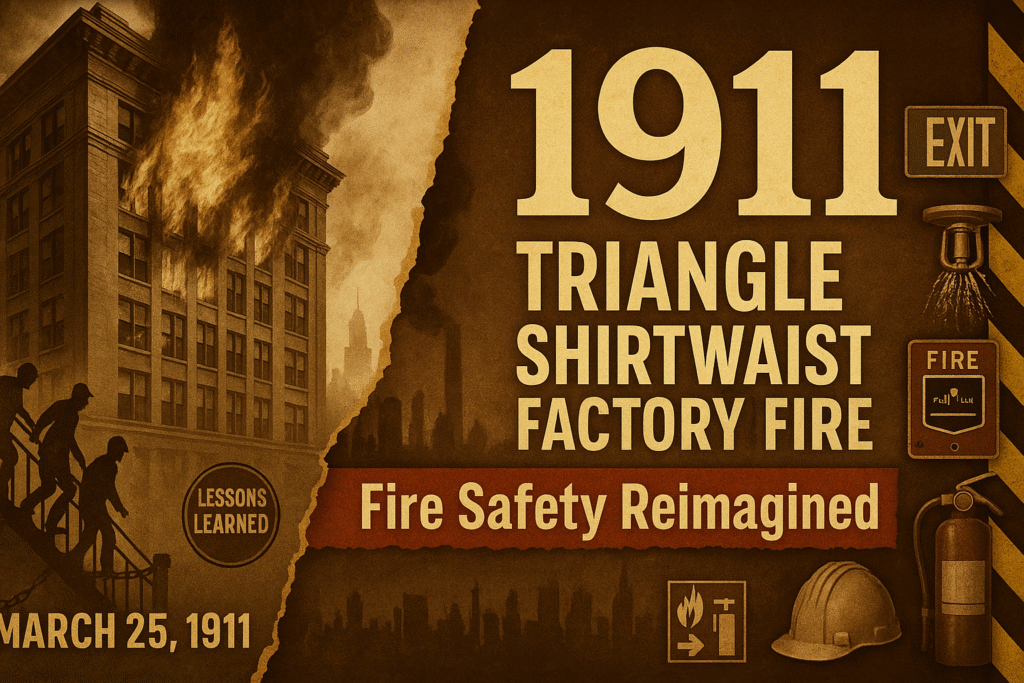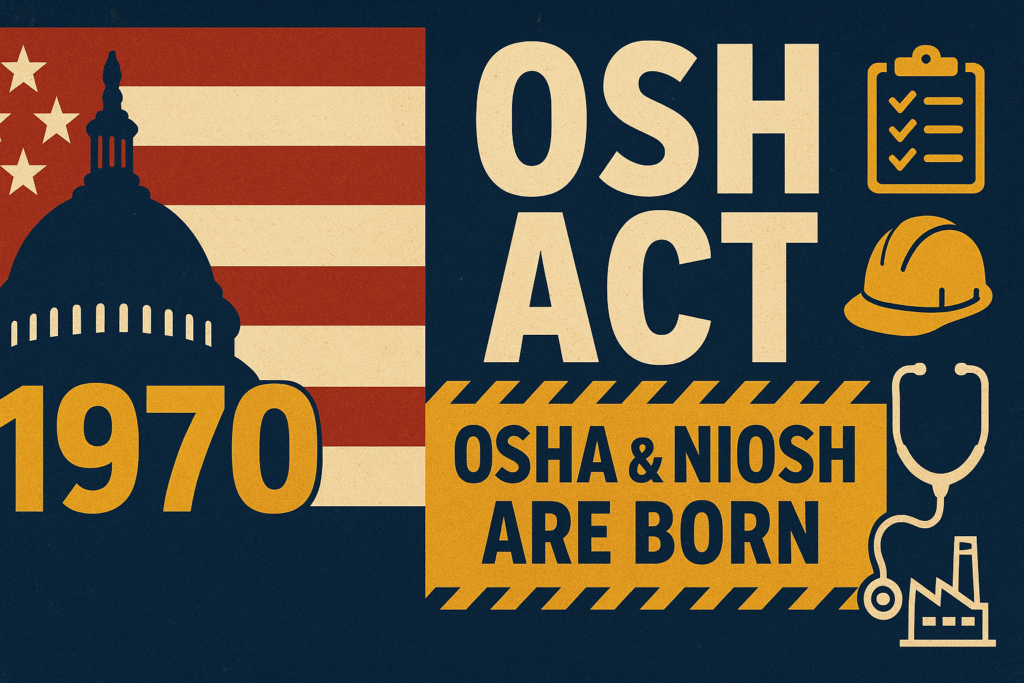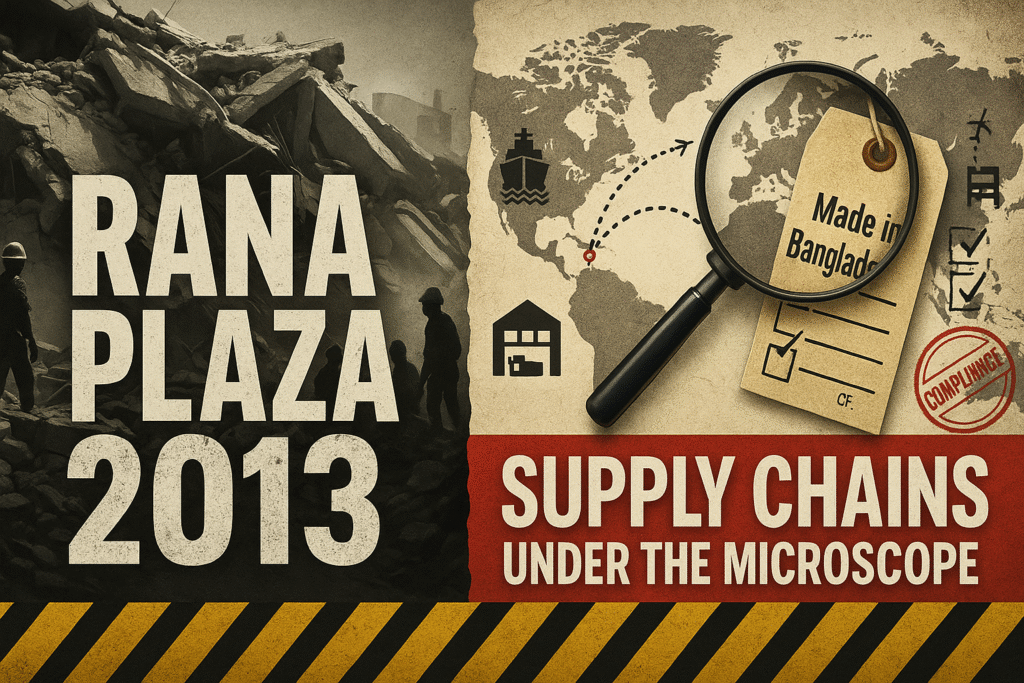Occupational health history is full of hard-won lessons that reshaped how we protect workers. In this deep dive, we explore 10 landmark moments—some inspiring, many tragic—that rewired laws, standards, and culture across industries.

Along the way, we’ll link you to authoritative resources and practical guides so you can turn history into action today.
10 Major Events in Occupational Health History
1) The 1833 UK Factory Act—The Birth of State Inspection
The Industrial Revolution delivered unprecedented productivity—and shocking human costs. The Factory Act of 1833 introduced state factory inspectors in Britain, regulating child labor, hours, and basic conditions.

This early enforcement model foreshadowed modern regulators and demonstrated that relying solely on voluntary compliance was insufficient.
In occupational health history, it’s the moment supervision and accountability became part of the job.
Practical takeaway: supervision matters. Even today, robust internal audits and competent person programs echo this 1833 insight—verify, don’t just trust.
2) 1911 Triangle Shirtwaist Factory Fire—Fire Safety Reimagined
In New York City, locked exits and inadequate safety measures turned a garment factory into a death trap, killing 146 workers—mostly young immigrant women.

The Triangle Shirtwaist disaster redefined egress, alarm, and sprinkler expectations, reshaping building and fire codes worldwide.
In occupational health history, it shows how single points of failure—locked doors, blocked stairs—can turn routine shifts into mass casualty events.
Practical takeaway: enforce unblocked exits, test alarms, track headcounts. See modern code guidance at the U.S. Occupational Safety & Health Administration (OSHA) and the UK’s Health and Safety Executive.
3) The “Radium Girls” (1917–1926)—Toxicology Comes of Age
Clock-dial painters were taught to “lip-point” brushes dipped in radium paint; many later developed radiation poisoning and jaw necrosis. Their legal fight elevated industrial hygiene, exposure science, and employer duty of care.
This episode remains a cornerstone of occupational health history, proving that invisible hazards (ionizing radiation, heavy metals, solvents) demand precaution even before all science is settled.
Practical takeaway: where science is emerging, apply precautionary controls—substitution, enclosure, and medical surveillance. WHO’s summary of Occupational Health offers global context.
4) Hawk’s Nest Tunnel Disaster (1930–1931)—Silicosis, Named and Confronted
At Gauley Bridge, West Virginia, hundreds of workers—many migrant laborers—were exposed to pure silica dust during tunnel drilling; thousands more later reported illness.
The tragedy forced recognition of silicosis as a preventable occupational disease, accelerating dust standards, ventilation, and wet methods.

In occupational health history, Hawk’s Nest shows how production pressure without controls converts a known hazard into a mass-fatality disease.
Practical takeaway: don’t accept visual cleanliness as safety; invest in air monitoring, engineering controls, and fit-tested respiratory protection. For program building, see our guide to Respiratory Protection.
5) 1950 ILO/WHO Joint Committee—Defining the Field
The International Labour Organization (ILO) and World Health Organization (WHO) formalized occupational health’s scope in 1950, emphasizing the promotion and maintenance of workers’ physical, mental, and social well-being.
This definition broadened the focus beyond injury prevention to include chronic diseases, ergonomics, and psychosocial risks—an enduring pivot in occupational health history.
See the ILO’s global frameworks and conventions at the International Labour Organization.
Practical takeaway: comprehensive OHS programs cover mental health, ergonomics, and long-term exposures—not just first aid and PPE.
6) 1970 U.S. OSH Act—OSHA and NIOSH Are Born
The Occupational Safety and Health Act of 1970 created OSHA (enforcement) and NIOSH (research), bringing national attention, standards, and enforcement authority to the workplace.
Inspection powers, recordkeeping, and worker complaint mechanisms standardized protections across states and sectors.

In occupational health history, this is the archetype of modern regulation: research-driven standards, inspections, and penalties.
Authoritative resources: OSHA.
Practical takeaway: pair policy with measurement. Injury/illness logs, exposure records, and leading indicators (near misses, safety observations) drive continuous improvement.
7) 1974 UK Health and Safety at Work etc. Act—Risk Management Culture
Guided by the Robens Report, the HASAWA 1974 reframed safety around goal-setting and risk assessment duties for employers, employees, and suppliers. It catalyzed the modern safety management system approach—proportionate, evidence-based, and consultative.
In occupational health history, HASAWA is the shift from prescriptive checklists to risk-led thinking.
Practical takeaway: embed hazard identification, risk evaluation, and worker consultation into daily operations. For policy structure tips, see our article on How to Write a Compliant Workplace Safety Policy.
8) 1984 Bhopal—Process Safety and Community Protection
A nighttime release of methyl isocyanate from a pesticide plant in Bhopal, India killed thousands and injured hundreds of thousands. Bhopal accelerated global process safety (PSM) requirements, emergency planning, and community-right-to-know transparency.
In occupational health history, it marks the realization that occupational incidents can become community disasters.
Practical takeaway: beyond PPE and training, high-hazard operations require process hazard analysis (PHA), management of change (MOC), mechanical integrity, and competency management—systematically audited and stress-tested.
9) 2013 Rana Plaza Collapse—Supply Chains Under the Microscope
When Rana Plaza collapsed in Bangladesh, it exposed structural risks in subcontracted supply chains. The tragedy spurred binding agreements such as the Accord on Fire and Building Safety, third-party structural audits, and remediation programs.

In occupational health history, Rana Plaza globalized corporate accountability—safety isn’t local when production is global.
Learn more at the Accord on Fire and Building Safety.
Practical takeaway: incorporate supplier audits, worker voice channels, and corrective action tracking into procurement—safety metrics belong in vendor scorecards.
10) 2020–2021 COVID-19—Infectious Disease as a Workplace Hazard
The pandemic made infectious disease a central workplace hazard: ventilation, filtration, cohorting, paid sick leave, and outbreak response plans became business-critical. Regulators issued emergency standards and guidance for healthcare, congregate settings, and essential services.

In occupational health history, COVID-19 cemented the role of public health + industrial hygiene collaboration and revived the hierarchy of controls—from elimination (remote work) to PPE.
Practical takeaway: treat indoor air like water—monitor, filter, and maintain it. Routine ventilation checks, CO₂ as a proxy for air changes, and layered controls now belong in standard OHS programs.
Patterns Across Occupational Health History (What They Teach Us Today)
1) Disasters expose systemic weak points. From Triangle to Bhopal to Rana Plaza, post-mortems consistently reveal known hazards unmanaged: locked exits, poor maintenance, ignored alarms, deferred repairs, or normalized deviance. Build mechanisms (walkthroughs, control verification, escalation pathways) that catch issues before they cascade.
2) Standards evolve—programs must too. HASAWA’s risk-based approach, OSHA’s enforceable rules, and global frameworks (ILO/WHO) show that compliance is a moving target.
Annual policy reviews, competency refreshers, and management review meetings keep programs aligned with current science and law.
3) Exposure science saves lives. The Radium Girls and Hawk’s Nest cemented the value of industrial hygiene—air sampling, dose limits, and medical surveillance. Today, silica, welding fume, VOCs, and psychosocial stressors demand the same rigor.
If you’re updating your respiratory or chemical control program, start with exposure assessment and documented control plans; our Respiratory Protection guide walks through selection, fit, and program documentation.
4) Safety is a system, not a slogan. Process safety (post-Bhopal) teaches that culture, engineering, and management controls must align.
Use formal methods: PHA/HAZOP, bow-tie analysis, and layers of protection analysis (LOPA). Track actions with due dates and owners; present to leadership like any other critical KPI.
5) Worker voice and transparency work. From early factory inspectors to modern whistleblower protections and supplier accords, progress accelerates when workers can surface risks without retaliation.
Build joint health and safety committees, publish leading indicators, and create easy-to-use reporting channels.
Turning History into Action (A Quick Checklist)
- Risk Assessments: Review top five tasks; verify controls against credible guidance (e.g., OSHA and HSE).
- Exposure Controls: Measure where you can; otherwise, assume worst-credible exposures and control accordingly.
- Emergency Preparedness: Drill evacuations, verify exits/alarms, and test communication trees.
- Supplier Safety: Add structural and fire safety checks to procurement for high-risk regions; reference the Bangladesh Accord model.
- Policy & Culture: Refresh your written policy annually and align it with worker participation. If you need a template, start with our in-depth guide to Workplace Safety Policy on OHSE.ca.
Conclusion: Why Occupational Health History Still Matters

These 10 moments prove that prevention is policy, design, and accountability—not luck. By studying occupational health history, we confront enduring truths: hazards compound in silence, controls degrade without verification, and lives depend on systems that work on a bad day.
Build your program as if the next footnote in occupational health history will be written about you—because, in a sense, it will.

No comments yet